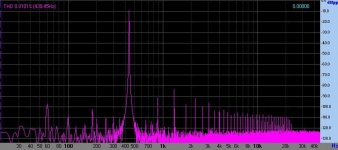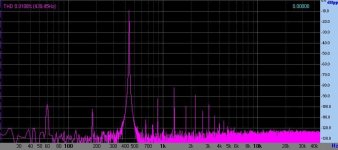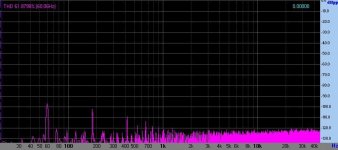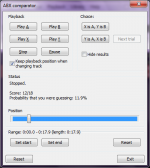Tried with speakers and headphones and impossible to discern it.
Tried with my "bad" amplifier and 12/12 another time. Only for curiosity I test the output for this amplifier and I get the images posted below. Harmonics are worsened much more for 440_opa549 than for 440_orig, and see H2 is lower.
Looks like the "bad" amp you use has real problems with low level signals. This might be a good candidate for the test with music, I mean it would be interesting to prepare test music files with your amplifier.
It would be very interesting to hear only the crossover distortion of your opa549 amp for an audio track. Can you post any?
Thanks in advance.
Okay, I did my best and tried hard, however the resulting extracted differential file has only linear distortions audible (caused by phase shifts due to subtle change in amplitude response with the amp), even if I tried the SW that should eliminate the phase shifts. So, with music, no audible crossover artifacts to be posted, sorry. I may try different music sample, but I doubt any success.
For those of you (and anyone who would like to participate again) who have complained on 16-bit resolution and music sample quality, I have prepared a new, much more "audiophile" test files at
http://pmacura.cz/toc549.zip
The files are in 48/24, the question is the same, please post your ABX result, but this time feel free to comment on your preferences and file sound impressions. Tested again track with and without the OPA549 amp, loaded this time by 6.8 resistor, for the reason that recording with loud playing speaker is really annoying.
http://pmacura.cz/toc549.zip
The files are in 48/24, the question is the same, please post your ABX result, but this time feel free to comment on your preferences and file sound impressions. Tested again track with and without the OPA549 amp, loaded this time by 6.8 resistor, for the reason that recording with loud playing speaker is really annoying.
Great test track 🙂 hmmm 😀 this is going to be a toughie as well.
Quick first listen and I thought I could attribute a signature to one (I'll not say what) but the ABX results show otherwise @ a 2/8 and 5/8. That was on headphones with a flat response and moderate volume.
Quick first listen and I thought I could attribute a signature to one (I'll not say what) but the ABX results show otherwise @ a 2/8 and 5/8. That was on headphones with a flat response and moderate volume.
Here my results for testing the occo and 400Hz archives
I already mentioned the "occo" result...
Well, I being honest here. The sine results are basically luck. I don't hear differences.
So I tested my equipment I've listened for limit
0.01% THD for a triode amplifier (at test volumes) is not too bad... 😀
Measured in the secondary, since the Stax 'phones are connected to primary and is too high voltage for the audio board (and impedances)
Is clearly visible the crossover distortion for the "bad" file.
I will try to measure with my test microphone to see if this "appears acoustically"
Of course, even the best phones will have far more low order distortion than my amp or the test files.
Sometimes is fun to play with. But for me causes very bad anxious effects, so at least because of this I don't use much ABX 😛
I already mentioned the "occo" result...
Well, I being honest here. The sine results are basically luck. I don't hear differences.
So I tested my equipment I've listened for limit
0.01% THD for a triode amplifier (at test volumes) is not too bad... 😀
Measured in the secondary, since the Stax 'phones are connected to primary and is too high voltage for the audio board (and impedances)
Is clearly visible the crossover distortion for the "bad" file.
I will try to measure with my test microphone to see if this "appears acoustically"
Of course, even the best phones will have far more low order distortion than my amp or the test files.
Sometimes is fun to play with. But for me causes very bad anxious effects, so at least because of this I don't use much ABX 😛
Attachments
I'll try again later. It is a good test track, super clean sound and good musically as well.
I believe that the others, especially those who called for 24-bit files, will join us.
Yes, that's about my average although I did manage a 2/8 somehow 🙁
I still want to give these a more thorough listen but have been pushed for time today.
I still want to give these a more thorough listen but have been pushed for time today.
* With Lacinator ABX was impossible
* With JRiver I can differentiate.
I like more Tocr.wav because it sounds more analog, with less shrill highs and more bass. More natural, credible and almost without fatigue.
PS: with the KEF Q100 speakers.
* With JRiver I can differentiate.
I like more Tocr.wav because it sounds more analog, with less shrill highs and more bass. More natural, credible and almost without fatigue.
PS: with the KEF Q100 speakers.
Last edited:
Yes, that's about my average although I did manage a 2/8 somehow 🙁
I still want to give these a more thorough listen but have been pushed for time today.
I am quite glad of the results of this thread, because it shows how complex this is and that any simplification based on 1 or 2 plots and numbers is quite invalid. I would like to turn attention to the result of mimi123
Test your ears in my new ABX test
as it shows that some amplifiers with very strange non-linearity may confuse the test results, see how his "bad amplifier" exaggerates low level signals by distorting them and thus changes test result. This is really very interesting. If he had not another, better amplifier, he could have said: "look, I heard it and have positive result!". And he supported the issue by measurement, which I appreciate very much.
That is quite an interesting scenario for sure. I have an ancient Rotel RA820 that was rebuilt using vertical FET's in the output stage, and the bias is adjustable down to zero. I might try that tomorrow and see if I can replicate mimi's result.
That would be nice, Karl. I have no worse amplifier than this OPA549 in this test. I hoped it would be enough, and it was not. On the contrary, it turned out as quite nice small amp.
* With 1by1 player I can differentiate but is more difficult and the sound is worse. KEF Q100 speakers.
* With Lacinator ABX was impossible
* With JRiver I can differentiate.
I like more Tocr.wav because it sounds more analog, with less shrill highs and more bass. More natural, credible and almost without fatigue.
PS: with the KEF Q100 speakers.
Thanks for your listening impressions, Maty. I will reveal which file is which later, after we possibly collect more opinions, because I do not want to bias further listeners.
I have installed AIMP v4.50, build 2042 and by default (without modifing anything) I can differentiate. I like more Tocr.wav again. Better sound than foobar2000 and 1by1 in my system but worse than JRiver 23.
Now with ASIO4All and optimized like the others multimedia players. They sound very similar but I like more the Tocl.wav !!!!!!!
With DirectSound I can not differentiate.
With Wasapi I like more Tocl.wav
"optimized like the others multimedia players" : same rules in Process Lasso.
With DirectSound I can not differentiate.
With Wasapi I like more Tocl.wav
"optimized like the others multimedia players" : same rules in Process Lasso.
Last edited:
Both Wasapi and ASIO almost always give cleaner analog output of the soundcard or DAC, than DS, Maty 🙂. The only way how to verify is to measure DAC output 🙂. Also, cards tend to work best at only one sampling frequency and with 24 bits. So it is very wise to use a SW resampler and feed the card with the format that gives the cleanest analog output .....
So it goes.
So it goes.
- Status
- Not open for further replies.
- Home
- General Interest
- Everything Else
- Test your ears in my new ABX test





